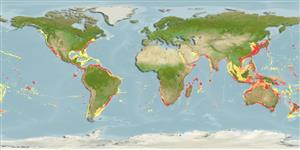>
Carangiformes (Jacks) >
Carangidae (Jacks and pompanos) > Naucratinae
Etymology: Seriola: Latin word diminutive with the meaning of a large earthenware pot (Ref. 45335).
Eponymy: Brazilian Sharpnose Shark Rhizoprionodon lalandii JP Müller & FGJ Henle, 1839 Pierre Antoine Delalande (1787–1823). (See Delalande) (Ref. 128868), visit book page.
More on author: Valenciennes.
Issue
Junior synonyms Seriola aureovittata Temminck and Schlegel, 1845 (in Japan, Northwest Pacific) and Seriola dorsalis (Gill, 1863) (in California, Pacific Baja, and the Gulf of California, Mexico; Northeast Pacific ) are considered valid with Seriola lalandi Valenciennes 1833 confined in Brazil, South Africa, Australia, New Zealand, and Chile (Southern distribution only), according to Martinez-Takeshita et al., 2015 (Ref. 121056).
Environment: milieu / Zona climática / intervalo de profundidade / distribution range
Ecologia
marinhas; estuarina bentopelágico; intervalo de profundidade 3 - 825 m (Ref. 4517). Subtropical; 18°C - 24°C (Ref. 6390); 55°N - 57°S, 180°W - 180°E
Circumglobal in subtropical waters: Series of disjunct populations. Indo-Pacific: South Africa, Walter Shoals, Amsterdam Island, Japan, Australia, New Zealand, New Caledonia, Hawaii, Rapa, Pitcairn Island, and Easter Island. Eastern Pacific: British Columbia, Canada to Chile (Ref. 2850), including Desventuradas Is. and Juan Fernández Is. (Ref. 89357). Eastern Atlantic: St. Helena, South Africa (Ref. 7097).
Comprimento de primeira maturação / Tamanho / Peso / Idade
Maturidade: Lm ?, range 51 - ? cm
Max length : 250 cm TL macho/indeterminado; (Ref. 27865); common length : 80.0 cm TL macho/indeterminado; (Ref. 9137); peso máx. publicado: 96.8 kg (Ref. 40637); idade máx. registrada: 12 anos (Ref. 72462)
Espinhos dorsais (total) : 5 - 6; Raios dorsais (total) : 33 - 35; Espinhos anais: 2 - 3; Raios anais : 20 - 21. The only jack without scutella on the caudal peduncle. Dark blue dorsally and almost white ventrally; with a well defined line of demarcation between the two colors.
Body shape (shape guide): fusiform / normal; Cross section: compressed.
Adults are benthopelagic in coastal and oceanic waters, off kelp beds and rocky areas (Ref. 2850), sometimes entering estuaries (Ref. 9563). They are solitary or in small groups and can be found near rocky shores, reefs and islands (Ref. 6390). Schools of juveniles are generally found in offshore waters, often near or beyond the continental shelf (Ref. 27865). They prefer warmer water (18-24°C) although they are occasionally found in cooler water (Ref. 27128). Adults feed on small fish, squid and crustaceans (Ref. 27121). Marketed fresh and salted or dried (Ref. 9283).
Paxton, J.R., D.F. Hoese, G.R. Allen and J.E. Hanley, 1989. Pisces. Petromyzontidae to Carangidae. Zoological Catalogue of Australia, Vol. 7. Australian Government Publishing Service, Canberra, 665 p. (Ref. 7300)
Status na Lista Vermelha da UICN (Ref. 130435: Version 2025-1)
Uso pelos humanos
Pescarias: pouco comercial; Aquacultura: experimental; peixe esportivo: sim
Ferramentas
Relatórios especiais
Baixar XML
Fontes da internet
Estimates based on models
Preferred temperature (Ref.
123201): 9 - 23, mean 14.9 °C (based on 1169 cells).
Índice de diversidade filogenética (Ref.
82804): PD
50 = 0.5020 [Uniqueness, from 0.5 = low to 2.0 = high].
Bayesian length-weight: a=0.01862 (0.01003 - 0.03456), b=2.92 (2.76 - 3.08), in cm total length, based on LWR estimates for this species & (Sub)family-body (Ref.
93245).
Nível Trófico (Ref.
69278): 4.2 ±0.1 se; based on diet studies.
Resiliência (Ref.
120179): Baixo, tempo mínimo de duplicação da população 4,5 - 14 anos (K=0.13; tm=2; tmax=12).
Prior r = 0.28, 95% CL = 0.19 - 0.42, Based on 5 data-limited stock assessments.
Fishing Vulnerability (Ref.
59153): High vulnerability (61 of 100).
🛈
Climate Vulnerability (Ref.
125649): Moderate to high vulnerability (50 of 100).
🛈
Nutrients (Ref.
124155): Calcium = 21.2 [12.9, 45.7] mg/100g; Iron = 0.82 [0.48, 1.56] mg/100g; Protein = 18.5 [15.5, 21.3] %; Omega3 = 0.387 [0.235, 0.660] g/100g; Selenium = 64.4 [33.2, 123.5] μg/100g; VitaminA = 23 [3, 158] μg/100g; Zinc = 0.461 [0.323, 0.665] mg/100g (wet weight); based on
nutrient studies.
